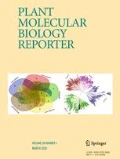Abstract
The cacti family is a morphologically heterogeneous group comprising 100 genera and about 1500 species (Hernandez and Barcenas, 1996). With the exception of one genus, all members of this family are native to America (Hernandez and Barcenas, 1996). There are three subfamilies, Opuntioideae, Cactoideae, and Pereskioideae (Gibson and Nobel, 1986). DNA isolation from cacti is notoriously difficult because they contain high amounts of polysaccharides and secondary metabolites which form insoluble complexes with nucleic acids during extraction (Guillemaut and Marechal-Drouard, 1992). Like in other groups of plants, the secondary metabolites and polysaccharides in cacti inhibit enzyme action (Porebski et al., 1997). The polysaccharides are visually evident by their viscous, glue-like texture and they make the DNA unmanageable when pipeting and hard to amplify by the polymerase chain reaction (PCR) (Poresbski et al., 1997). We report an easy and inexpensive protocol to isolate DNA from cacti. We used this method to isolate DNA from 85 species (170 individuals) of 39 genera of the subfamilies Pereskioideae, Opuntioidea, and Cactoideae. This procedure is a modification of a protocol described by De la Cruz et al. (1995) for the Cacti family. It requires only a few grams of tissue and does not require destruction of the whole plant to produce high molecular weight genomic DNA. The DNA from this procedure can be amplified consistently by PCR and used for RAPD analysis.
Similar content being viewed by others
References
De la Cruz, M.R. Whitkus, L.M. MotaBravo. 1995. Tropical tree DNA isolation and amplification. Mol. Ecol. 4: 787–789.
Dellaporta, S.J., J. Wood, J.B. Hicks. 1983. A plant DNA minipreparation: Version II. Plant Mol. Biol. Reptr. 1: 19–21.
Flament, I. 1989. Coffee, cocoa and tea. Food Rev. Int. 5: 317–414.
Gibson, A.C., P.S. Nobel. 1986. The cactus primer, pp. 18, 188–206. Harvard University Press.
Guillemaut, P., L. MarechalDrouard. 1992. Isolation of plant DNA: a fast, inexpensive and reliable method. Plant Mol. Biol. Reptr. 10: 60–65.
Hernandez, M.H., R.T. Barcenas. 1996. Endangered cacti in the Chihuahuan Desert: II. Biogeography and conservation. Con. Biol. 10: 1200–1209.
Murray, M.G., W.F. Thompson. 1980. Rapid isolation of high molecular weight plant DNA. Nucleic. Acid. Res. 8: 4321–4325.
Porebski, S.L., G. Bailey, R.B. Baum. 1997. Modification of a CTAB DNA extraction protocol for plants containing high polysaccharide and polyphenol components. Plant Mol. Biol. Reptr. 12: 8–15.
Author information
Authors and Affiliations
Rights and permissions
About this article
Cite this article
de la Cruz, M., Ramirez, F. & Hernandez, H. DNA Isolation and Amplification from Cacti. Plant Molecular Biology Reporter 15, 319–325 (1997). https://doi.org/10.1023/A:1007428818078
Issue Date:
DOI: https://doi.org/10.1023/A:1007428818078




